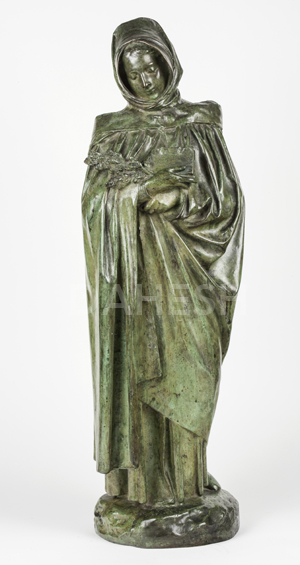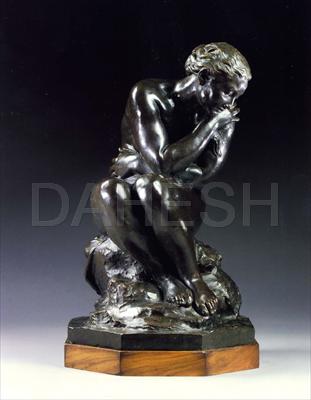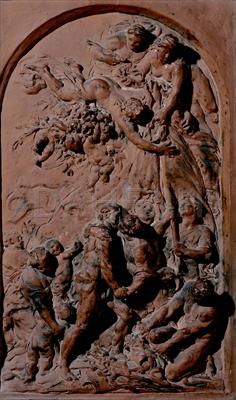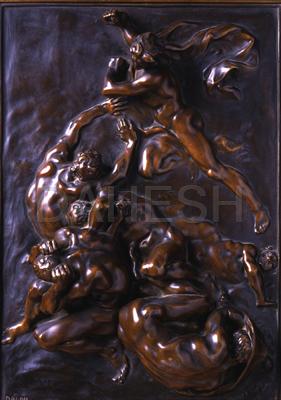- About
- Visit
- Exhibitions
- Collection
- Overview
- Search the Collection
- Recent Acquisitions
- SPOTLIGHT ON …
- Bouguereau’s “Amiable” Pictures Cross the Atlantic
- Back to Work
- The Allure of Animals in Academic Art
- Classical Mythology in 19th-century French Art
- Celebrities: Portrait medals in 19th-Century France
- Oriental “Native Types” from the Dahesh Collection
- Recording Islamic Architecture and Design
- French Natural Selections
- Painting Piety from the Dahesh Collection
- About Face: Learning to Draw Emotion through Expressive Heads
- From St. Petersburg to Paris: The Education of Russian Artists in France
- Picturing the News: The Birth of the Illustrated Press
- Egyptomania: 19th Century Depictions of Ancient Egypt
- The Franco-Prussian War and Its Aftermath in French Art
- Painting Pompeii: From Neoclassicism to the Néo-Grecs
- The Spanish Orient and Henri Regnault (French, 1843–1871)
- Women Artists Who Dared II: Jeanne Thil (French, 1887–1968) and Marie Hadad (Lebanese, 1889–1973)
- Women Artists Who Dared I: Rosa Bonheur (French, 1822–1899) and Elizabeth Gardner Bouguereau (American, 1837–1922)
- Peder Mork Mønsted’s (Danish, 1859–1941) Poetic Views of Nature
- Publications
- Programs
- Shop
- News
Search Results for: ‘Dalou’
-
Aimé-Jules Dalou, The Woman of Boulogne
Aimé-Jules Dalou (French, 1838–1902)
The Woman of Boulogne
Bronze with green patina, 24 3/4 x 7 7/8 x 6 5/8 in.
Signed on base back top: Dalou
Foundry mark on base back bottom edge center: SUSSE Fres PARIS …rcue
Foundry mark on base bottom right: SUSSE FRÈRES EDITEURS PARIS.
Inscribed on base bottom right: Susse Fes EJes Paris
Gift of Tracy and Laurel Pulvers
2014.5
Best known for his public monuments in Paris, in 1870 Dalou began to create statuettes of women. During his exile in London from 1871 to 1879, he executed a series of women from Boulogne—a theme made popular by the paintings of Alphonse Legros, who also lived in England at the same time. The original composition, entitled Palm Sunday at Boulogne, was exhibited at the Royal Academy in 1872 and purchased by George Howard, later Earl of Carlisle. A girl returning from church, clasps a prayer book and a branch of leaves, indicating the Palm Sunday mass. In London, Dalou frequently exhibited at the Royal Academy and taught at the National Art Training School in South Kensington (later the Royal College of Art), where he had a profound influence on the development of British sculpture.
-
Aimé-Jules Dalou, Bather
Aimé-Jules Dalou (French, 1838–1902)
Bather, or Before the Bath, modeled ca. 1890, cast ca. 1902
Patinated bronze, 22 x 14 x 13 3/4 in.
Signed on base right: DALOU. Foundry mark on base top right: CIRE PERDUE A.A. HÉBRARD, and numbered on base bottom right: B-3
2002.54
Dalou began to model his first bather compositions during his exile in England between 1874 and 1876, and the subject remained of great interest to him for the rest of his life. The plaster for the present composition is kept in the Musée du Petit Palais in Paris, which has the largest holdings of the artist’s oeuvre. A marble version was carved in 1899, but no lifetime bronze casts exist, as the artist discouraged the production of commercial editions of his work. However, several of the models were cast from 1902, first by the Hébrard and subsequently by the Susse foundries.
-
Aimé-Jules Dalou, Fraternity
Aimé-Jules Dalou (French, 1838–1902)
Fraternity, ca. 1883
Patinated plaster, 20 x 13 1/4 in.
Signed lower right: DALOU. Inscribed upper center: Alliance des Peuples Mairie du Xe
2002.56
This relief repeats the composition of one of two large plaster reliefs Dalou exhibited at the Salon of 1883. The two spectacular works earned the artist the gold medal at that year’s Salon as well as the Légion d’honneur. The bronze version of Fraternity can be seen today in the marriage chamber of the mairie (town hall) of the 10th arrondissement of Paris.
-
Aimé-Jules Dalou, The Punishments
Aimé-Jules Dalou (French, 1838–1902)
The Punishments, or Les Châtiments, modeled mid-1880s
Bronze bas-relief, 14 1/8 x 10 1/4 in.
Inscribed lower left: Dalou. Foundry mark lower right: Susse Fes Edts. Stamped lower right: H.
2002.59
Dalou is recognized as one of the foremost sculptors of the 19th century. His many public sculptures, such as Charity (1877–79, Royal Exchange, London) and Triumph of the Republic (1879–99, Place de la Nation, Paris), attest to his strong belief in social and political equality and brotherhood, as did his grand unrealized project called Monument to Workers. After the fall of the Paris Commune in 1871, Dalou went into exile in London, where he also enjoyed acclaim for his portraits and more intimate subjects depicting women.
Les Châtiments (The Punishments) is a collection of Victor Hugo’s (1802–1885) satirical poems attacking Emperor Napoleon III (reigned 1852–1870) after his 1851 coup. Hugo published this work two years later in Belgium, where the author had gone into exile. After the fall of the Second Empire in 1870, the work was republished in France. Dalou made this relief so that an etching after it might be included as a frontispiece to a national edition of Hugo’s works. He later exhibited a bronze cast of this relief at the Salon of 1890. Dalou admired Hugo both as an artist and as a political man, and this relief is one of several works by Dalou associated with the great Romantic writer. Surely his admiration had grown during the 1870s: Dalou himself was in exile for his involvement with the Paris Commune, and Hugo demanded persistently that amnesty be granted to the Communards.
-
Virtual Salon: Alternate Careers Workshop

Because of hiring freezes at museums and universities, younger scholars are increasingly worried about their future. In response, the Association of Historians of Nineteenth-Century Art and the Dahesh Museum of Art are co-sponsoring a Virtual Salon on Sunday, August 8 at 7PM EDT to explore alternate career paths for their consideration. Speakers include:
Alison W. Chang, who earned her doctorate at the University of Pennsylvania in 2010, with a dissertation on Edvard Munch. She is Program Officer at the American Council of Learned Societies, where she manages several of the organization’s fellowship programs, including those specifically related to art history. Previously she was the Director of Communications, Marketing, and Membership at CAA. Her current scholarly interests include contemporary Scandinavian artists, critical race theory, and printmaking.
Andrew Eschelbacher, who earned his doctorate from the University of Maryland in 2013 with a dissertation on the French sculptor Jules Dalou. After teaching at the Virginia Military Institute, he joined the Portland Art Museum, where he was Associate Curator before being appointed as Director of Curatorial Affairs at the American Federation of Art. He is editor of A New American Sculpture, 1914–1945 (Yale, 2017).
Paul Provost, who earned his doctorate from Princeton University in 1994 with a dissertation on Winslow Homer. He has over twenty-five years’ experience in museums, business, and foundations: he began at New-York Historical Society, then for more than two decades he was Deputy Chairman at Christie’s, after which he founded the arts consulting firm Provost & Associates. He has been closely involved with World War II Holocaust and Restitution matters and other cultural property claims. Currently he is Chief Executive Officer of Art Bridges, the new arts foundation dedicated to expanding access to American Art.
Matt Woodworth, who earned a doctorate from Duke University in 2011 with a dissertation on English Gothic architecture. He worked for three years in Scotland as author of the Pevsner Architectural Guides published by Yale University Press, taught for three years at Duke as Visiting Assistant Professor, then, in 2018, founded Curated Touring, which arranges private European travel for individuals or small groups. See: https://www.curatedtouring.com; and https://www.forbes.com/sites/everettpotter/2019/10/23/curated-touring-avoiding-the-crowds/?sh=6423584616fc.
This event is free and open to the public, but registration is required. Please register through the following link: https://tinyurl.com/altcareers-art.
-
DAHESH MUSEUM OF ART ANNOUNCES FIVE NEW ACQUISITIONS
— World-Renowned Collection of 19th-Century Art Continues to Grow
Prior to Moving to New Museum Space —
New York, April 1, 2015 – The Dahesh Museum of Art today announced the acquisition of five new works that will significantly enhance its world-renowned collection of 19th-century art. The acquisitions, spanning 1851 to 1874, include three bronze statues, one oil on canvas painting, and one pencil and watercolor study heightened with gouache on card. The works are by artists Marius Jean Antonin Mercié (1845–1916), Aimé-Jules Dalou (1838–1902), Rosa Bonheur (1822–1899), and Sir Lawrence Alma-Tadema (1836–1912).Rosa Bonheur was the focus of an international retrospective created by the Dahesh Museum of Art in 1997; this is the seventh work by Bonheur to enter the Dahesh Museum collection. The watercolor study by Alma-Tadema is the preparatory work for a finished painting that is also within the Museum’s holdings. Alma-Tadema is among the most collectible Victorian artists (his painting The Finding of Moses sold at Sotheby’s in 2010 for $36 million). The three sculptures, by artists Mercié and Dalou, were a gift from Tracy and Laurel Pulvers.
“We are grateful to add these important works to our collection, and to eventually make them available to the public once we open at our new space at 178 East 64th Street,” said J. David Farmer, Director of Exhibitions for the Dahesh Museum of Art. “We have been actively acquiring new work for the past four years, and these works expand our growing insight into the 19th century and elaborate upon works we already possess.”
New Acquisitions
Marius Jean Antonin Mercié (French, 1845–1916)
David, ca. 1872
Bronze, brown patina, 25 1/2 x 12 3/4 x 17 7/8 in.
Signed on base, top right: A. MERCIÉ. Stamped on base at side back center: REDUCTION MECANIQUE A. COLLAS BREVETÉ.
Gift of Tracy and Laurel Pulvers
2014.4Mercié, one of the most successful sculptors of late 19th- and early 20th-century France, began as a pupil of François Jouffroy and Alexandre Falguière at the École des Beaux-Arts in Paris. He won the Prix de Rome in 1868 and found immediate success with the first plaster model of David that he executed while in Rome. This sculpture offered a glimmer of hope for France after its crushing defeat by Prussia in 1871. David, armed with a slingshot, brought down the giant Goliath, proving that France too could triumph over its enemy. The State awarded Mercié the Legion of Honor and in 1872 commissioned a bronze version of David (Musée d’Orsay). The Barbedienne foundry cast a miniature version in six different sizes.
Marius Jean Antonin Mercié (French, 1845–1916)
Gloria Victis (Glory of the Vanquished), modeled ca. 1874, cast after 1879
Bronze, dark brown patina with gilt highlights, 36 5/8 x 21 x 16 in.
Signed on base right: A. MERCIE. Inscribed on base at front edge: GLORIA VICTIS. Foundry mark on back base: F. BARBEDIENNE, Fondeur Paris. Stamped on back base: REDUCTION MECANIQUE A. COLLAS BREVETE.
Gift of Tracy and Laurel Pulvers
2014.3Mercié executed the plaster model for this group while studying in Italy as a Prix de Rome boursier and exhibited it at the 1874 Salon. The winged female figure carrying a wounded soldier holding a broken sword expresses the loss and sacrifice of the French at the hands of the Prussians in the 1870-71 war. The sculpture won critical and popular acclaim. In his review of the Salon that year, the critic Jules-Antoine Castagnary observed: “while monarchists quarrel over the debris of our battered fortunes…there exists a young sculptor who has undertaken to speak directly to our nation and to console our people who have suffered so much.” Mercié received a medal of honor, the city of Paris purchased the sculpture for 12,000 francs, and the model was cast in bronze by Thiébaut et fils (Musée du Petit Palais, Paris). Replicas of it adorned monuments dedicated to those who served in the Franco-Prussian War in many towns and cities throughout France, and the Barbedienne Foundry provided bronze reproductions in different sizes.
Aimé-Jules Dalou (French, 1838–1902)
The Woman of Boulogne
Bronze, green patina, 24 3/4 x 7 7/8 x 6 5/8 in.
Signed on base back top: Dalou. Foundry mark on base back bottom edge center: SUSSE Fres PARIS …rcue. Foundry mark on base bottom right: SUSSE FRÈRES EDITEURS PARIS. Inscribed on base bottom right: Susse Fes EJes Paris
Inscribed on base, bottom right: Susse Fes EJes Paris
Gift of Tracy and Laurel Pulvers
2014.5Best known for his public monuments in Paris, in 1870 Dalou began to create statuettes of women. During his exile in London from 1871 to 1879 following the fall of the Paris Commune, he executed a series of women from Boulogne—a theme made popular by the paintings of Alphonse Legros, who also lived in England at that time. The original composition, entitled Palm Sunday at Boulogne, was exhibited at the Royal Academy in 1872 and purchased by George Howard, later Earl of Carlisle. A girl returning from church clasps a prayer book and a branch of leaves, referencing the Palm Sunday mass. In London, Dalou frequently exhibited at the Royal Academy and taught at the National Art Training School in South Kensington (later the Royal College of Art), where he had a profound influence on the development of British sculpture
Rosa Bonheur (French, 1822–1899)
Going To Market, 1851
Oil on canvas, 19 x 27 1/4 in.
Signed and dated lower right: Rosa Bonheur 1851
2014.6When 29-year-old Bonheur painted Going to Market, her reputation as an animal painter was already firmly established. The composition, peasants with their ox-drawn carts, demonstrates Bonheur’s command of animal anatomy, which she had studied at horse fairs, cattle markets, and in the family menagerie. While Bonheur won the highest artistic and governmental honors in France, her works were also greatly admired in Great Britain and the United States.
Sir Lawrence Alma-Tadema (Dutch/British, 1836–1912)
Study for Joseph, Overseer of Pharaoh’s Granaries, ca. 1874
Pencil and watercolor heightened with gouache on card, 16 3/4 x 22 in.
2014.7This sheet by Alma-Tadema is related to the splendid painting in the Dahesh Museum collection, Joseph Overseer of Pharaoh’s Granaries (acquired in 2002), first exhibited in 1874 at the Royal Academy. The subject derives from the Book of Genesis, with Joseph seated on a throne in his role as the Pharaoh’s overseer of the royal granaries, accompanied by a scribe reading him the account of sales. The finished painting follows the general composition and colors of the sketch, with the addition of details of the ancient Egyptian decorations and accoutrements. This study was previously in the collection of Andy Warhol.
About the Dahesh Museum of Art
The Dahesh Museum of Art is the only institution in the United States devoted to collecting, exhibiting, and interpreting works by Europe and America’s academically trained artists of the 19th and early 20th centuries. The Dahesh serves a diverse audience by placing these artists in the broader context of 19th-century visual culture, and by offering a fresh appraisal of the role academies played in reinvigorating the classical ideals of beauty, humanism, and skill. Visit us at: http://www.daheshmuseum.org.


